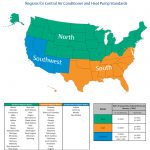The Energy Independence and Security Act of 2007 provided for the next round of government regulated standard efficiencies allowed for air conditioners sold in the Unites States. These new standards will go into effect on January 1, 2015. What is unique about these new efficiency standards is that they have allowed for different standards for various parts of the country rather than having just one national standard. Similar to the standard efficiency increases experienced in 2006 when the minimum went from 10 SEER to 13 SEER, this regulation will apply to all equipment, whether it is being installed in an existing structure as a system replacement or in a new structure.
Here is a summary of what you need to know about the new regulations (also, see the map and table below):
Northern States – Minimum 13 SEER air conditioning remains the standard, but heat pumps go to 14 SEER and 8.2 HSPF.
Southern (Southeastern) States – Minimum efficiency goes to 14 SEER for both air conditioning and heat pumps and 8.2 HSPF for heat pumps. The 8.2 HSPF/14 SEER heat pump rating will become a national standard.
Southwestern States – Minimum efficiency also goes to 14 SEER for air conditioning, but there is a new standard for EER that will call for 12.2 EER for systems less than 45,000 BTUH and 11.7 EER for systems over 45,000 BTUH. Heat pumps require national standard of 14 SEER and 8.2 HSPF
What can you do?
Here are few things you can do to prepare for these new standards:
- Stay in touch with us via this site or our other contractor support sites as we get closer to the implementation date
- Watch for OEM’s to change their product offerings to be ready for these new standards. Emerson is working directly with all the major OEM’s to help them be ready, but each one may have a slightly different approach to meet the needs of three different regions.
- Train your employees on the latest in new equipment which will feature electronic controls, variable speed blower motors and more. You will need to stay current through Emerson training or through your OEM’s training.
What questions do you have about the regulation changes?
Related Articles
How to Speak with Customers About Refrigerants



